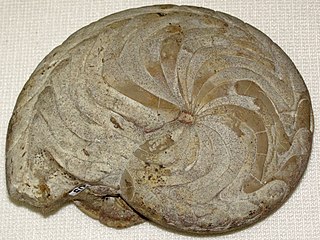
Goniatites is a genus of extinct cephalopods belonging to the family Goniatitidae, included in the superfamily Goniatitaceae. Hibernicoceras and Hypergoniatites are among related genera.
Aphantites is a Lower Pennsylvanian ammonite belonging to the goniatitid family Reticuloceratidae which are characterized by involute subdiscoidal shells covered by linear or biconvex growth lines that may be crossed by longitudinal lirae, producing a reticulate pattern. Sutures are simple, the ventral lobe double pronged. Related genera include Surenites and Reticuloceras.
Agastrioceras is a genus of cephalopod belonging to the Reticuloceratidae family. They are an extinct group of ammonoid, which are shelled cephalopods related to squids, belemnites, octopuses, and cuttlefish, and more distantly to the nautiloids.
Axinolobus is a genus belonging to the Axinolobidae family. They are an extinct group of ammonoid, which are shelled cephalopods related to squids, belemnites, octopuses, and cuttlefish, and more distantly to the nautiloids.
Asturoceras is an extinct late Paleozoic ammonoid cephalopod genus belonging to the Goniatitida, named by Ruzhencev and Bogoslovskaya in 1969.
Uraloceras is an ammonoid cephalopod genus belonging to the goniatitid family Paragastrioceratidae. The genus was named by Ruzhencev 1936 and is a jr. synonym of Pseudogastrioceras Spath 1930 according to Miller, Furnish and Schindeworlf, 1957. More recent classifications however list the two as distinct genera and put Uraloceras in the Paragastrioceratinae and Pseudogastrioceras in the Pseudogastrioceratinae.

Tornoceratina is one of two suborders included in the Goniatitida, characterized by generally involute, subdiscoidal shells and by sutures in which the ventral ones are undivided.
Dimeroceratoidea, formerly Dimerocerataceae, is one of six superfamilies in the goniatitid suborder Tornoceratina which lived during the Devonian. Five families are included, the Dimeroceratidae being the type family.

Prionoceratoidea is a superfamily in the goniatitid suborder, Tornoceratatina that was extant during the latter Paleozoic.
Pseudohaloritoidea, formerly Pseudohaloritaceae, is one of four superfamilies of the goniatitid suborderTornoceratatina. Although attributed the Ruzhencev, 1957 T.J Frest et al. included the Maximitidae and Pseudohaloritidae in the Cheilocerataceae in their May 1981 paper.
Falcitornoceratinae is one of three subfamilies of the Tornoceratidae family, a member of the Goniatitida order. Shells produced are extremely involute and have no umbilicus. Young and intermediate whorls have ventrolateral grooves. The adventitious lobe, which develops ontogenetically between the external, or ventral, and lateral lobes, is widely rounded. Tornoceratids in which the Falcitornoceratinae are included are involute, subdiscoidal, with sutures that form 6 to 10 lobes.

Neoicoceratoidea, formerly called Neoicocerataceae, is one of seventeen superfamilies of the Goniatitina suborder. Neoicoceratoidea comprises forms previously included in the Neoioceratidae and Metalegoceratidae, previously included in the Goniatitacae. These, along with new families defined for certain genera, including one from the Schistoceratidae, have been recombined as the Neoicocerataceae.
The Cravenoceratidae is one of six families included in the ammonoid superfamily Neoglyphioceratoidea, which lived during the latter part of the Paleozoic era.
Karagandoceratoidea is an Early Carboniferous (Mississippian) superfamily within the ammonoid order, Goniatitida, said to contain the Karagandoceratidae and Prodromitidae.
The Karagondoceratidae is a small family of tornoceratin Goniatitida from the Lower Carboniferous which typifies the Karagandoceratoidea, in which it is included.

Paraceltites is a genus of ammonoid cephalopods in the ceratitid family Paraceltitidae, known from the Middle and Upper Permian of Sicily, the Alps, Crimea, Texas and Mexico. The shell of Paraceltities is evolute with whorls compressed, venter arched and smooth, sides bearing ribs that slant somewhat forward dorso-ventrally. The suture is simple and goniatitic.
Cravevoceras is an Upper Paleozoic ammonite in the goniatite family Cravenoceratidae, probably derived from Pachylyroceras and contemporary with other cravenoceratid genera like Caenolyroceras, Tympanoceras and later Alaoceras and Lyrogoniatites. It is also a member of the Neoglyphioceratoidea.

Kosmoclymenia is a genus in the ammonoid order Clymeniida, in the family Kosmoclymeniidae.
Elephantoceras is genus of a Middle Permian ammonite belonging to the goniatitid family Pseudohaloritidae. Fossils belonging to this genus were found in China.
Aulacaganides is monospecific genus of a Middle Permian ammonite belonging to the goniatitid family Pseudohaloritidae. Fossils belonging to this genera were found in Hunan province of China.





